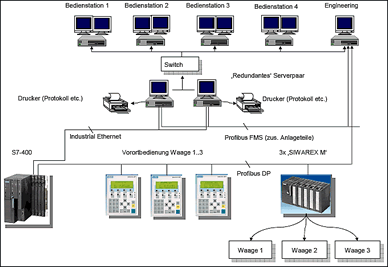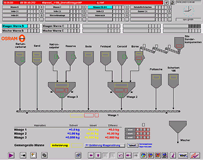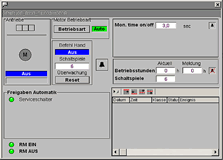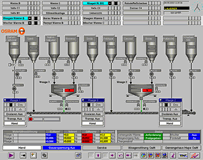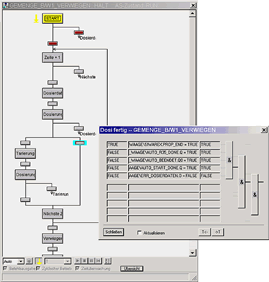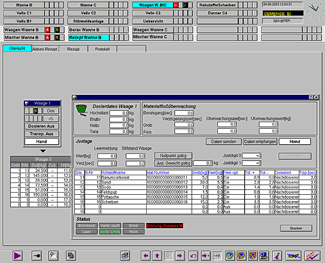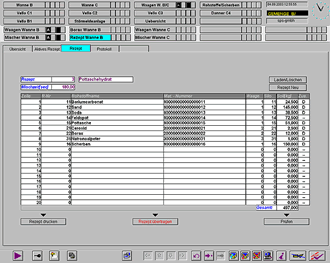Modernizing the batch plant at OSRAM
SIMATIC PCS7 als Basis eines modernen und offenen Steuerungskonzeptes
Upgrading and modernization of feeders and weighing plants are difficult and time-consuming, because these plants often appear as a black box. In most cases, any manipulation of the hardware and software components is restricted to the system manufacturer, with shocking expenses for spare parts, updates, and services. In comparison, modern technology provides an open system with standard components from the automation world. Such a system permits simple and supplier-independent enlargements, adjustments, and service of plants even in the future. Schlemmer Prozess Systeme GmbH supports this open concept in modernizations as well as in reconstructions of their Batch Plant Systems.
In the following, the retrofit of the batch plant at OSRAM in Augsburg shall illustrate this open concept.
Before renovation, the existing system consisted of 16 year old dosing technology with a master SIMATIC S5 control system. Process controlling of batch transportation and the three scales was handled through two operator panels and a PSC7 control level. Until renovation, controlling and control level had been connected via Profibus FMS. Highest attention was turned to the fact that the existing operating concept should be preserved during redesigning of the weighing plant. Plant processes and operator panels should feature the same functionality as they did before the reconstruction.
During further meetings at the house of OSRAM we agreed on modifying the control level images with graphic elements from the standard library. Faceplates are used for the operation and monitoring of aggregates (measuring point, motors, valves etc. Those are detailed images merged into a single operator object, which is interconnected with the SPS program and can be opened within the process window by mouse clicking. This results in additional operating and monitoring options for every aggregate – display of all errors and operator reports, alarm settings, operating modes, status reports, parameter entries, etc.
The existing weighing equipment including the SPS control system was completely removed for the reconstruction. All other elements, such as control cabinets, terminals, switches, etc. persisted. According to OSRAM´s requirements, the existing hardware layout has been adapted to WSCAD 4.2.
Control and dosing functions run within the automation system. Single components, such as motors, valves, etc., are triggered through the SIMATIC S7-400 inputs and outputs. Raw materials are weighed by Siemens SIWAREX M modules which perform the dosing procedure autonomous. Once a component has been weighed out, the following one is treated the same but it will be waited for a complete scale standstill. With several scales at one site, each one works independently. All relevant data (set points, switch-off values, ranges of tolerance, etc.) are transmitted to the scale via a corresponding control dialog of the process control system.
Process control system>
The process control system PCS7 is the basis for controlling and monitoring. All process-relevant plant states, error reports, and maintenance interval reminders (aggregates) are displayed on the PC screen. For this purpose, OSRAM was provided with screen blocks from the PCS7 library (for scales, motors, valves, etc.). Acquisition, recording, and analysis of batches are handled within the system database (MSSQL). The data can be further processed by EPS systems, such as SAP/R3. To ensure high availability, the software was designed for redundant operation, which means that a second server will supply the operator panels in case of failure of the first.
Scales and dosing controlling
PCS7 systems make use of the so-called “Continuous Function Chart” (CFC) as the basic programming language. Existing functions are graphically connected and it leads quickly to the goal, even without profound programming skills. In OSRAM´s case, programming of the sequential steps was performed in the SFC of the PCS7 system. This graphic tool allows presentation of the process by means of steps (blocks) and transitions (step enabling conditions). Such a SFC can be opened by mouse clicking within the runtime system (visualization) and displays the actual process status in different colors, with free assignment of colors to their respective process states. Error sources, which can cause production downtimes, can be diagnosed and repaired with this tool even without a programming tool.
Recipe management
The raw materials, which must be weighed out can be connected to the bunkers through an input mask. Additionally, every raw material is assigned a parameter set of metering data – coarse flow shut-off, fine flow shut-off, tolerances, metering mode, etc. If fine flow is chosen, the shut-off value can be automatically optimized by the SIWAREX module. In the overview picture, active batches are displayed according to their respective scales.
The recipe management allows setting-up, editing, deleting, and saving of recipes. An existing batch can be sent to a tank furnace or the current recipe can be printed. Once a recipe´s total weight exceeds the maximum gross load, unloading can be forced by the special function `E´. During a weighing procedure no changes in a recipe are possible.
Date and time, batch and formula number, raw material weights, and the total batch load will be archived, after weighing out all batch components. The batch data are written in the system database (MSSQL). When changing to another recipe, setpoint values are additionally included in the batch record. The record can be printed manually or automatically at change of shifts. A batch counter indicates the total sum of batches weighed out.
In terms of expandability, maintenance, and lowering of costs, OSRAM is now prepared for the future, due to the changeover of the weighing and dosing equipment to the open concept from SPS Schlemmer Prozess Systeme GmbH. From now on, the dependency on a single supplier is over. As a competent partner, SPS Schlemmer Prozess Systeme GmbH assists you in the realization of projects at home and abroad.

